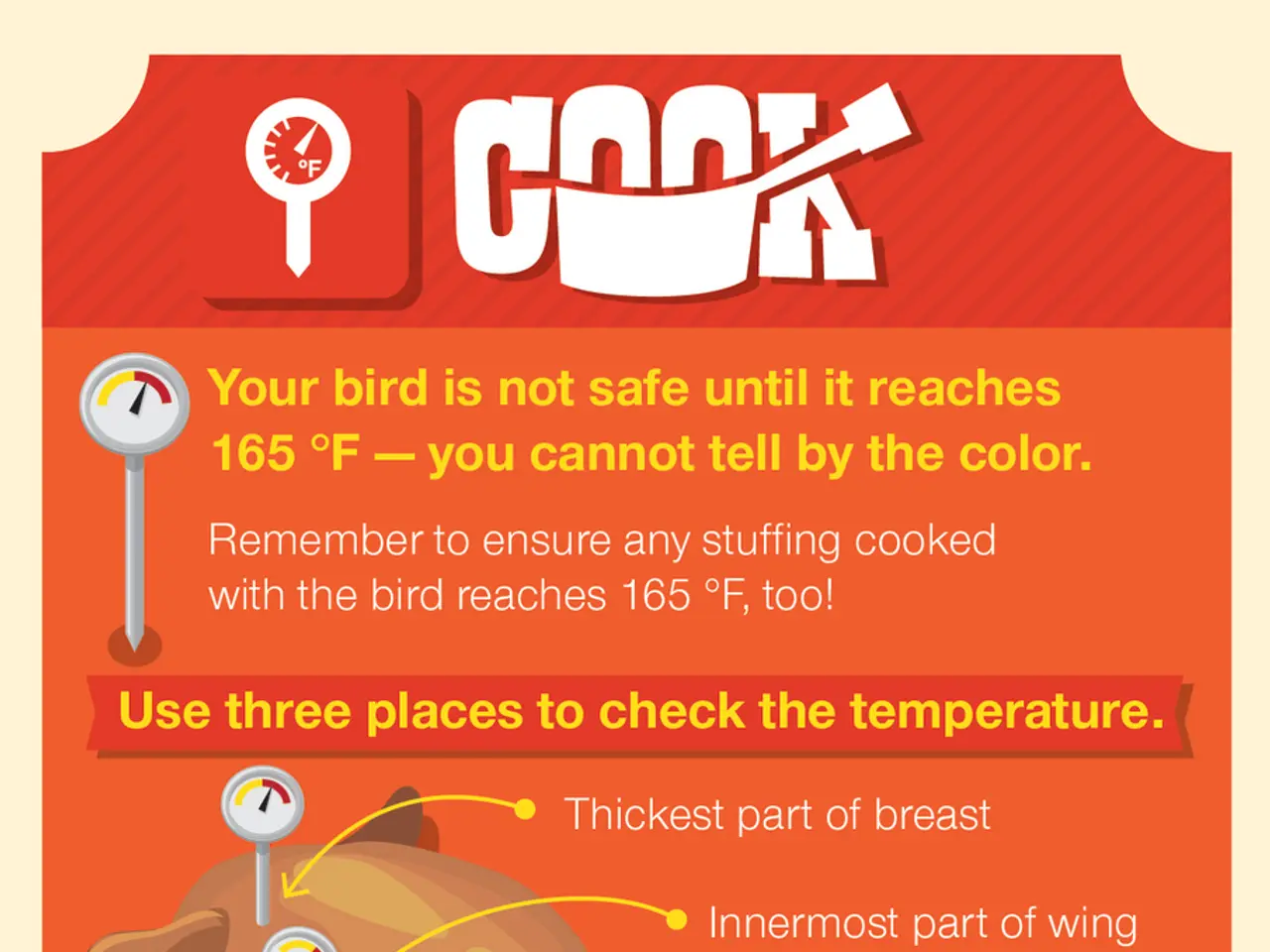Chicken Cholesterol Breakdown: Variations by Part and Preparation Method
Chicken, a staple in many diets, offers a lean source of protein. However, the cholesterol content in chicken varies across different parts and preparation methods. Here's a breakdown of the cholesterol content in various raw chicken parts and popular chicken dishes.
Cholesterol Content in Different Raw Chicken Parts
- Chicken breast (skinless): This is the leanest part, low in saturated fat and cholesterol, and often recommended for a heart-healthy diet. A 100-gram serving contains roughly 165 calories, 31 grams protein, and is relatively low in cholesterol compared to other parts[1][3].
- Dark meat (thighs, legs): Contains higher fat content, including more unsaturated fats. It typically has more cholesterol than white meat, but the impact on blood cholesterol is complex and varies per individual dietary patterns[4].
- Chicken skin: Contains the highest fat content and cholesterol. It is primarily fat and significantly raises cholesterol intake if consumed, increasing heart disease risk[5].
- Organs (liver, lungs): Some organ meats are high in cholesterol and may harbor bacteria or toxins, especially lungs, which pose health risks[5]. These are generally avoided or consumed in moderation.
Popular Chicken Dishes and Cholesterol Content
Chicken dishes that include skin or dark meat or are fried tend to have higher cholesterol due to added fats (oils, butter), skin consumption, and cooking methods such as frying that increase fat content[1][5]. Lean options like grilled, baked, or steamed chicken breast without skin preserve the low cholesterol benefits.
How Preparation Methods Affect Cholesterol Levels
- Removing skin greatly reduces cholesterol and saturated fat intake[1][3].
- Grilling, baking, steaming are healthier cooking methods that do not add extra fats, thus keeping cholesterol levels lower[2][3].
- Frying or cooking with added butter/oil increases fat and cholesterol content in the dish[1][2].
- Avoiding processed chicken products (like fried chicken, chicken nuggets, or products with skin) also helps to control cholesterol levels[1].
Summary
| Chicken Part | Cholesterol & Fat Content | Healthier Preparation Notes | |------------------------|----------------------------------|-----------------------------------------| | Skinless chicken breast | Lowest cholesterol and fat | Best for low cholesterol diets; grill/bake/steam | | Dark meat (thighs/legs) | Moderate cholesterol, more fat | Moderation advised; remove skin; use healthy cooking | | Chicken skin | Highest fat and cholesterol | Avoid or consume sparingly | | Organs (liver, lungs) | High cholesterol; possible toxins| Often avoided; important to cook thoroughly |
Choosing skinless white meat and cooking it via grilling, baking, or steaming helps keep cholesterol intake low, while consuming skin or frying chicken raises cholesterol levels significantly[1][3][5].
Individuals can manage cholesterol through diet, exercise, weight management, quitting smoking, and managing stress. However, if these lifestyle management tools are not enough, there are medications and other medical interventions available. For those with familial hypercholesterolemia, a treatment called lipoprotein apheresis filters LDL cholesterol from the bloodstream.
[1] Mayo Clinic (2021). Chicken nutrition facts. Retrieved from https://www.mayoclinic.org/foods/chicken/nutrition-charts/chicken [2] American Heart Association (2021). Healthy grilling tips. Retrieved from https://www.heart.org/en/healthy-living/healthy-eating/eat-smart/tips-and-recipes/healthy-grilling-tips [3] Harvard T.H. Chan School of Public Health (2021). Healthy eating plate. Retrieved from https://www.hsph.harvard.edu/nutritionsource/healthy-eating-plate/ [4] Cleveland Clinic (2021). Chicken nutrition facts. Retrieved from https://my.clevelandclinic.org/health/articles/11621-chicken [5] American Diabetes Association (2021). Cholesterol. Retrieved from https://www.diabetes.org/healthy-living/medication-treatments/treatments-for-diabetes/cholesterol
- A diet focused on atopic individuals might want to reconsider consuming chicken breast with skin, as it contains the highest fat and cholesterol.
- Chronic diseases like Alzheimer's, depression, diabetes, spondylitis, ankylosing spondylitis, obesity, COPD, dermatitis, cancer, and cardiovascular health can significantly benefit from a diet low in cholesterol, such as one that favors skinless chicken breast.
- The science of predictive medicine emphasizes the importance of maintaining good health-and-wellness practices, including fitness-and-exercise, mental-health management, and proper nutrition, which can all contribute to lower cholesterol levels.
- In addition to lean protein sources like chicken breast, mental-health considerations such as depression and stress can be managed through a balanced diet rich in nutrients and low in cholesterol.
- As part of a heart-healthy diet, nutritionists often recommend consuming skinless chicken breast due to its low cholesterol content.
- Regular exercise and weight management are crucial components in any comprehensive approach to managing chronic diseases like Alzheimer's, depression, diabetes, etc., and they can be complemented by a diet with low cholesterol content, such as one that focuses on skinless chicken breast.
- A health-conscious individual might prefer to avoid popular chicken dishes like fried chicken or chicken nuggets, as their high cholesterol content can contribute to chronic diseases and cardiovascular health issues.
- Certain medical conditions, like diabetes and cardiovascular health issues, require management strategies that include monitoring and controlling cholesterol intake through diet, exercise, and medication if needed.
- Chicken, when prepared via healthier cooking methods such as grilling, baking, or steaming, can be a beneficial addition to a diet focused on managing chronic diseases and maintaining cardiovascular health.
- The medical community emphasizes the importance of a well-rounded approach to managing chronic diseases and maintaining general health, which includes paying attention to nutrition, exercise, mental health, and avoiding excessive cholesterol intake from foods like chicken skin or processed chicken products.






